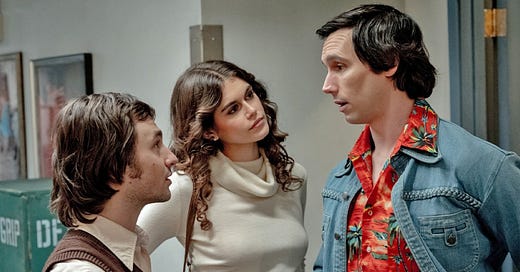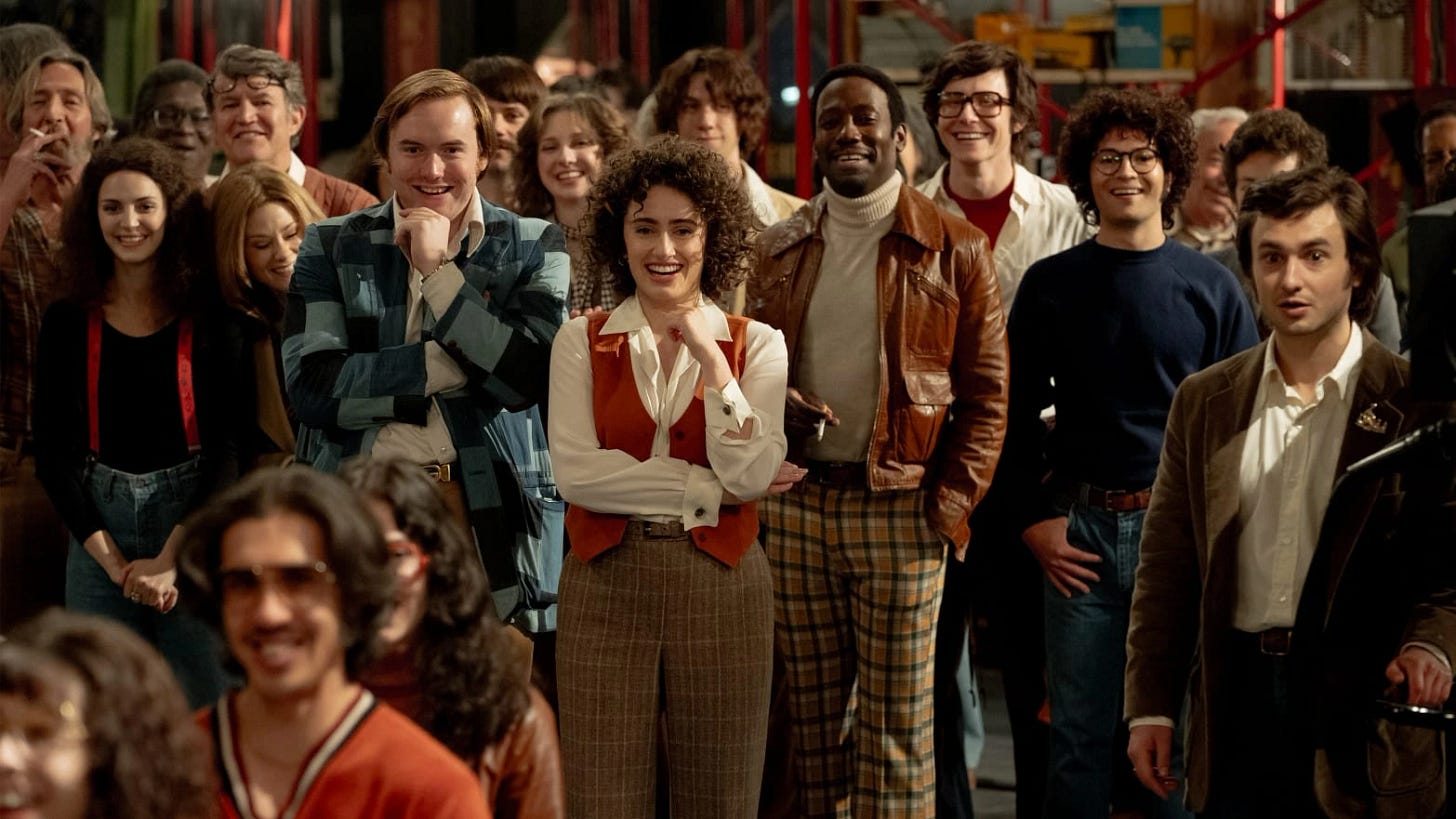In The Treatment’s early days, I had a subcolumn where I would review the reviews that I wrote as a film criticism youngster with the knowledge/experience/instincts I possess now. It never advanced past my revisit of my Inside review, partially because I think I’ve outgrown the person who reviewed those reviews, funnily enough. That, and there are simply other things I’d rather do here.
Nevertheless, I believe there’s a place on my publication for some version of revisiting my old work reviews, namely by taking the juiciest, most Treatment-coded bits and expanding/centering them in a way that I didn’t have the freedom to back then.
One of these reviews was for Saturday Night1, the 2024 bio-dramedy from Jason Reitman depicting the 90 minutes leading up to the 1975 premiere of Saturday Night Live on NBC. Together with the two newest Ghostbusters movies, Saturday Night is among the list of things that I’ve yet to forgive Reitman for.
Why? We’ll get to that, but first, let’s talk about chameleon cinema — one of the most essential filmic concepts that I’ve ever made up on the spot.
In a nutshell, chameleon cinema is what you get when a filmmaker recognizes the unique cinematic potential of a given subject or setting, and goes the distance to realize said subject or setting in its movie form, rather than just making a movie about said subject or setting.
Challengers — wherein Luca Guadagnino maximized the cinematic potential of tennis (both the court/paraphernalia and the game itself) — is my personal favourite example. The camera doesn’t just point at the court; it occupies the perspective of the ball and actively seeks frame compositions using the unique boundaries/geography of the court.
The drama, meanwhile, unfolds in the style of a tennis match. To quote my dear friend and fellow film critic Francisca Tinoco, “Every dialogue is a point, every scene is a game, every act is a set, and the whole film is a match.”
Challengers is not simply a tennis movie; it’s tennis in movie form — tennis grafted onto the chameleonic medium of film.
In the case of something like Saturday Night, your subject is, of course, SNL — one of the most revolutionary capsules in the history of broadcast entertainment, and a defining piece of American culture. Not the snuggest shoes to fill, in other words.
As such, why should an SNL biopic2 be any less innovative and visionary than what Lorne Michaels brought to the table back then?
Well, it shouldn’t, especially considering that SNL is the perfect playground for the practice of chameleon cinema, which fundamentally demands innovation — why settle for being a film about the premiere of SNL when you could be a film that has SNL woven into its narrative and technical DNA?
First, let’s consider what makes SNL what it is, taking into consideration both its origin and its legacy. We know that Lorne Michaels assembled a ragtag group of unknown comedians with the goal of launching many a career on network television, playing to his X-Men’s strengths by pitching a sketch comedy show that’s performed live.
These unknown comedians, of course, were destined to become generational talents thanks to the also-destined cultural thrust of SNL, and it became these very comedians (and all the comedians that would follow) that the American public kept showing up for. These sketches didn’t just delight because of how they were written and acted; they delighted because of the personalities that were bringing them to life. We laugh at the Old Prospector because we know it’s Will Ferrell, who we actively contextualize with all the other roles we’ve seen him play on SNL.
That’s built-in tension; we’re always waiting for our favourite cast member to show up, and we’re always anticipating what they’re going to do with the next character. And whenever a new cast member rears their head, there’s an air of anticipation to see how/what they’re going to do.
The question, then: how do you take these dynamics and apply them to a narrative film? How do you get chameleon cinema out of SNL?
Simple. You just do what Reitman already does with Nicholas Braun in this movie, except bigger.
For those of you who aren’t aware, Braun plays a dual role in Saturday Night, portraying both Jim Henson and Andy Kaufman, the latter of whom he plays as Kaufman’s Foreign Man character, as if that’s how Kaufman was in real life.
It’s in Braun that Saturday Night recognizes the unmistakably singular nuances of SNL and realizes them in an admirably novel manner that only cinema could. We chuckle because we know it’s Nicholas Braun, and we’re waiting to see what he does next with Henson and Kaufman/Foreign Man as characters3, mostly in terms of line delivery and what’s being said in the context of this network television pressure cooker.
The obvious expansion of this, of course, is for Saturday Night to treat the OG SNL talent in the same way — as characters that the film’s actual actors double or triple up on. That way, we’re responding not just to the snappy dialogue and outrageous zingers4, but to the anticipation of seeing those actors pop up again, seeing which character they pop up as, and how they subsequently play them.
And the expansion of that? Have the film’s cast members trade characters often; give Dylan O’Brien the Dan Aykroyd costume for one scene, and then pass it off to Cooper Hoffman for the next one, culminating in a smorgasbord of comedic interpretations of yesterday’s generation of up-and-coming talent, from today’s generation of up-and-coming talent.
And the expansion of that? Take this approach and also apply it to the more grounded, dramatic scenes, rather than just the comedic ones. By doing this, you substitute comedic tension with dramatic curiosity — how do these actors express the dramatic sides of these characters, and how do their expressions differ from the way that other actors dramatically express the same character? That’s the cinematic hook that an SNL movie needs.
So you see? There’s an effective limitlessness to the way that the spectre of SNL can be baked into the narrative and technical elements of Saturday Night, and that’s even before you take the cast into account. You don’t cast full-body movie stars — replete with untouchability — for a film like Saturday Night; you want actors that we can recognize the underdog scrappiness and awkward confidence of the original SNL players in.
Indeed, you want Rachel Sennott, you want Nicholas Braun, you want Andrew Barth Feldman, and you certainly want a relative unknown like Matt Wood. Of those who didn’t appear in Saturday Night’s cast, Tony Revolori and Sophia Lillis are two names that could also work with respect to these parameters.
If you want to get really nuclear, you get the current SNL stars to cameo as the network execs, and maybe bring in Pete Davidson as George Carlin.
So why, pray tell, did Saturday Night settle for being a coked-up panic attack? There’s ostensible entertainment value in the mania of it all, yes, but that’s the only real note that this approach has, and the subject matter of Saturday Night isn’t narratively nutritious enough to supplement that note.
Because what story is really being told with Saturday Night? The one underneath this significant network television miracle? One of teamwork? Perseverance? The unpolished insanity/seediness of the network television underbelly that’s so strategically hidden from us?
Arguably, but these are all happenstance themes. Saturday Night spends little time interrogating these things with any sort of nuance, instead opting for escalation upon escalation of artistic frustration, stubbornness, and animosity. Storytelling was very clearly not the mandate here.
And honestly? It shouldn’t have been. SNL, after all, quite famously never centred storytelling, and in fact actively disregarded it. Is it not cinematically appropriate for the definitive SNL biopic to do the same? I would certainly say so.
It remains, though, that you can’t just decenter storytelling in a scripted narrative feature without building up a significant replacement for it, and the game-time cacophony of the Saturday Night we got is certainly no such replacement — that approach is generic enough, in fact, that you could even wonder why this is an SNL movie in the first place.
That to say, any story could have been the backdrop of Reitman’s chaos chowder here, but the cracking of the SNL egg is a very distinct and momentous occasion, and the approach to its cinematic realization should be treated as such.
And you do that by making Saturday Night a piece of chameleon cinema. Stitch the near-patented SNL structure (or non-structure) to the filmmaker’s tools and zap the result with a bolt of lightning. Turn your actors into SNL players and turn the SNL players into costumes. Rotate your actors to take advantage of the SNL-styled comedic tension. Keep Gabriel LaBelle as the lone, consistent throughline in Lorne Michaels, tasked with playing the straight-man in a sea of cartoon characters. Have him break, Jimmy Fallon-style, in certain scenes. There’s oh so very many knobs to turn in the pursuit of a bone-deep SNL biopic.
Instead, Reitman seems to have stopped the buck at being relieved of the responsibility of nutritious storytelling while pouring all of the effort into an unsustainable vibe, and I can’t for the life of me figure out why — how can you utilize Nicholas Braun in a dual role like this and not realize that that’s the movie?5
But hey, it got a good CinemaScore6, so what do I know?
As in, a biopic about SNL itself, rather than any of its human tentpoles.
And again, in the context of an SNL movie, playing a character-within-a-character as Kaufman’s Foreign Man is a stroke of genius.
Which, by themselves, cannot comprise a sturdy comedic identity. Check out my American Fiction piece for further reading on this topic.
I found this out as I was writing this post, but apparently this dual role wasn’t even in the original plans for this movie. Benny Safdie was originally cast as Kaufman, but then had to drop out, getting replaced by the already-cast-as-Henson Braun.
Read that again. The bar-none strongest aspect of this specific film manifested by total accident. I don’t think I’ll forgive Reitman for this, either.
B+, specifically.









I really like your idea of chameleon cinema, but I can’t agree with your angle here. To dislike a film for not fulfilling your vision is a fallacy at best, despite simultaneously being a showcase of your own creative tenacity. (To be honest, I much prefer your version over what we got, but what we got was still fine).
I’d rather view Saturday Night as refreshing in the face of Reitman’s filmography. Ghostbusters was bs, and I’m not a fan of Juno, but Saturday Night really worked for me as a boiler plate kind of film. I even rewatched it to try and come to terms with the negative review I had been seeing last year, but my opinion did not change. It’s a pretty solid movie with little formal qualities outside of the usual conventions: ticking clock to induce urgency, swooping cameras during dialogue scenes (which I liked because dialogue scenes are always tough to shoot and edit, and giving them movement is challenging). I also felt like it was calling for some sort of cultural revolution in some mundane, corporate way. The general theme of young voices rising above the old is super relevant and one of the main tenets of Filmstack itself.
Love this take on the movie. i would have much preferred your version.
I found that Curb your Enthusiasm did this well too. The Producers season followed the same plot as the stage show, while the Seinfeld reunion season was just that, and played into the tropes of a reunion in each episode.